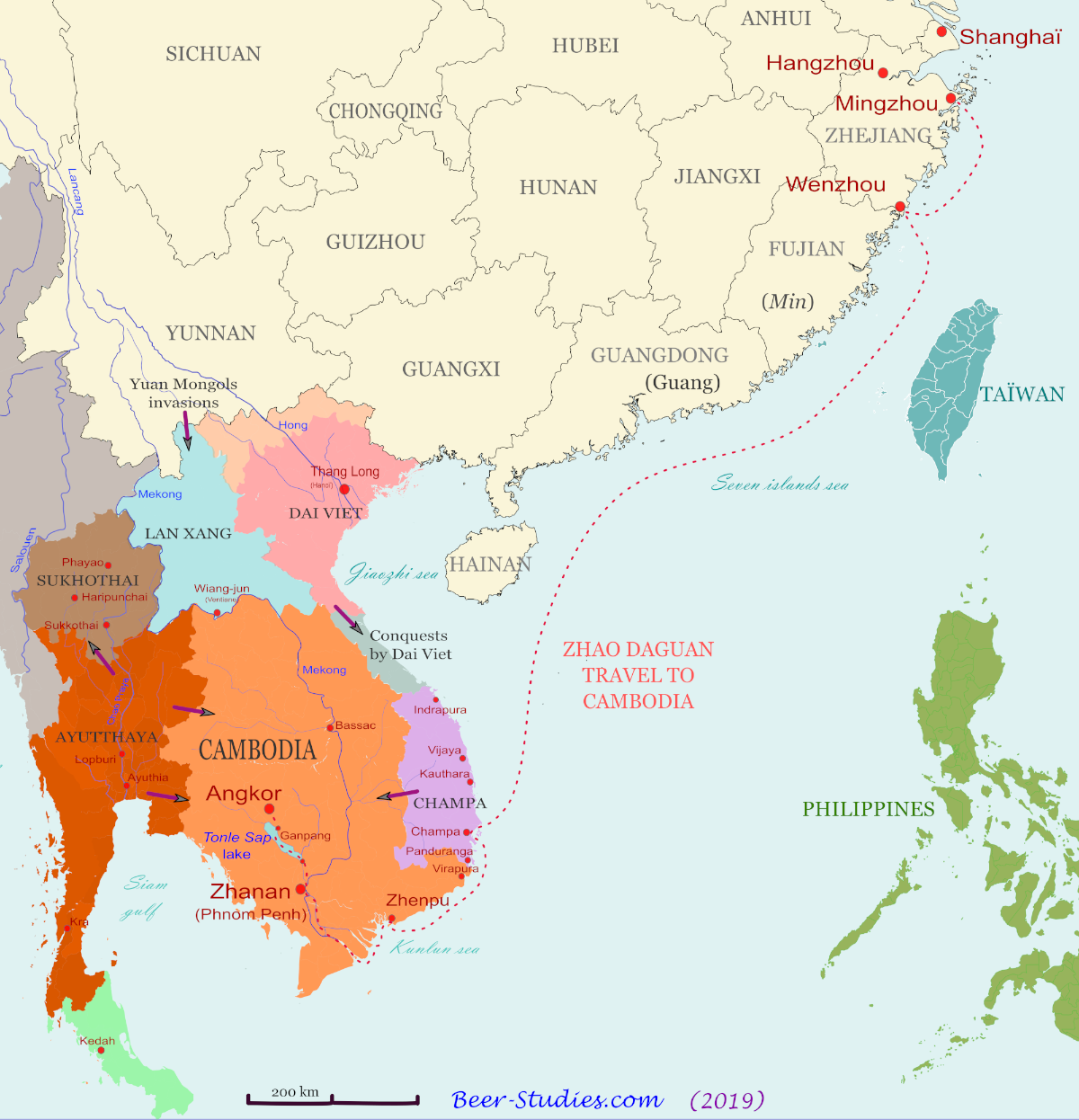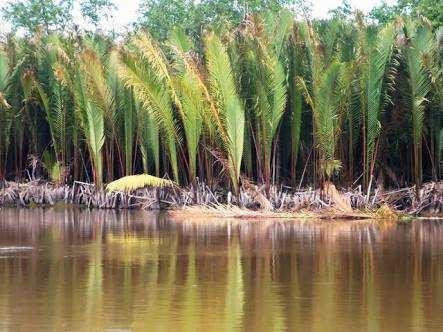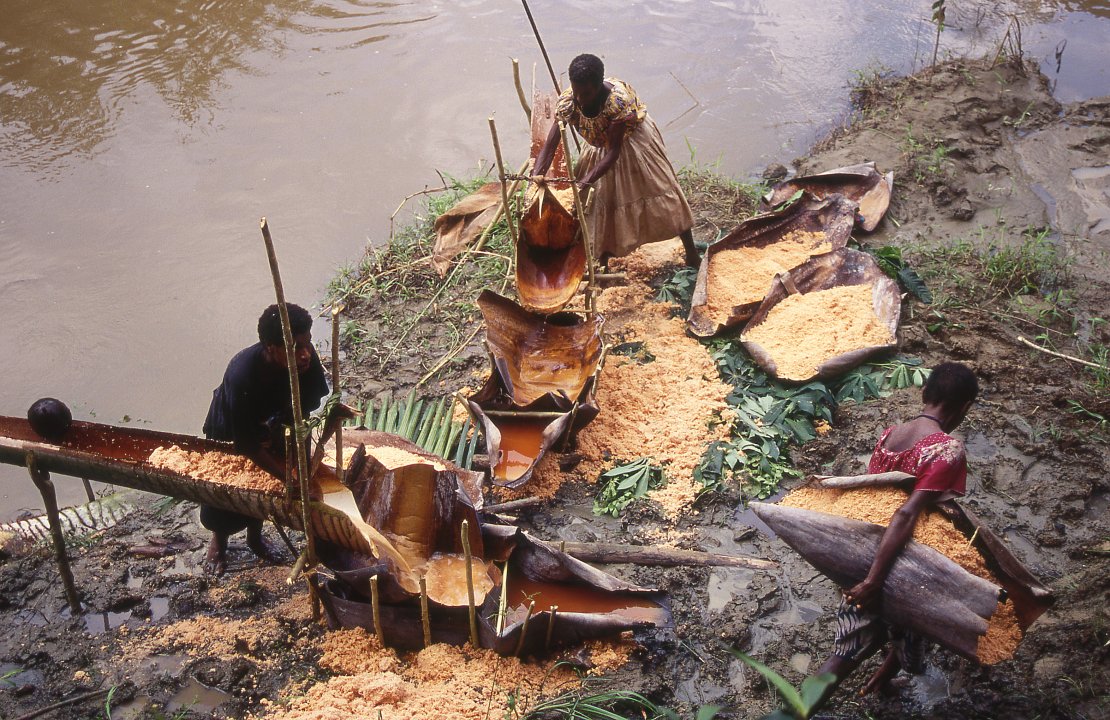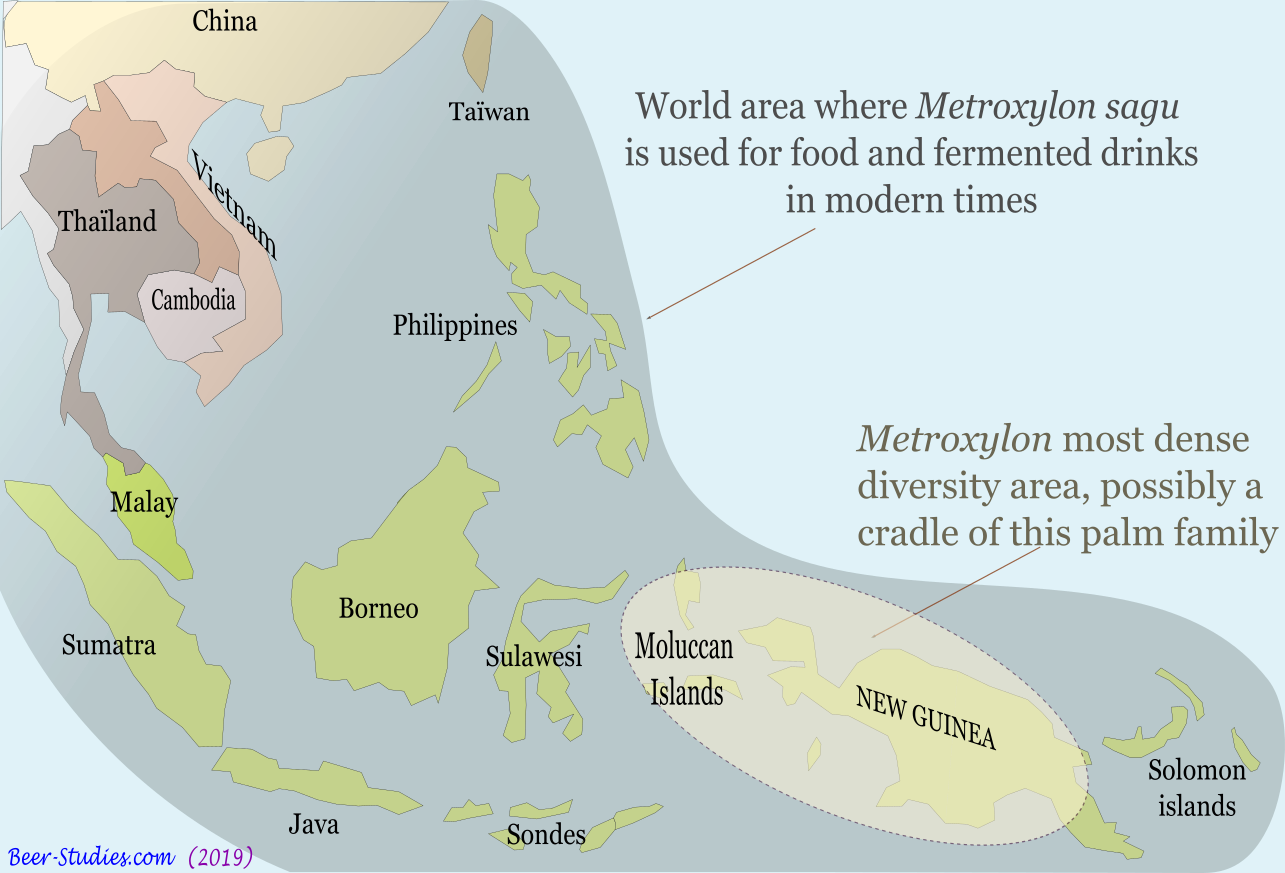Your search results [1 article]
Zhou Daguan's journey to the Khmer court in 1296 and the beer from sago-palm.
In August 1296, Zhou Daguan (modernised form of Cheu Ta-Kuan) accompanied a Chinese embassy to Cambodia, to the court of the Khmer kings. The Chinese delegation stays in the country for a year, mainly in Angkor where the Yasodharapura, the huge palatial and religious complex of the then ruling Khmer dynasty and its king Indravarman III (1295-1308). Returning to China in late 1297, Zhou Daguan wrote a Memoir for the Yuan court that ordered this embassy, the Zhenla fengtu ji, or Memoir of Cambodia, Country and People. This document is to date the only eyewitness description of ancient Cambodia. It describes what Zhou Dagan observed in Cambodia at the height of its power in the late 13th century[1]. Zhou Daguan describes the customs of the country, court life, religious rituals, palaces and their architecture, the life of the people, etc. We do not have the original text written by Zhou Daguan, but an abridged version included in various anthologies published under the Yuan (1271-1368) or under the Ming (1368-1644)[2].
Chapters 27 and 28 deal with fermented liquors and beer ferments. They led to the selection of this document as a milestone in the history of brewing. The latter informs us, alas succinctly, of the beers brewed at that time in the Khmer kingdom: one kind made from rice and another brewed with the starch of the sago palm (or other similar species of starchy marrow palm). The Cambodians use the plant-based ferment technique to brew beer, a general technique also used in China at the same time. Zou Daguan came from southern China and therefore understood this technical principle.
"27. Fermented beverages. - These people have four classes of wines (jiu=酒). The first is called by the Chinese "honey-sweet wine" (密糖酒); it is prepared by means of a fermenting drug mixed with honey and water. The next, which the natives call p'ong-ya-sseu (pengyasi, 朋牙四), is made with leaves of a tree, p'ong-ya-sseu is the name of the leaves of a certain tree. The third is beer made from husked rice, or leftover cooked rice which is called bao-leng-jiao (包稜角); bao-leng-jiao means husked rice. Last comes sugar-bright wine (糖鑑酒) [crystallized sugar?]; it is made with sugar. When you go down by the banks of the estuary, they also have a flour palm beer (茭漿酒) made with the starch from the leaves [stems] of a palm tree [jiao] that grows on the banks of the river." (Paul Pelliot 1951, 29)
"28. Salt, vinegar, soy (Soy sauce) - There are no restrictions on the use of salt works in this country. All along the coast, from Tchen-p'ou and Pa-kien, salt is obtained by cooking sea water. In the mountains, there is also a mineral whose flavour outweighs that of salt; it can be cut and made into objects.
The natives do not know how to make vinegar. If they wish to make a sour sauce, they add leaves of the hien-p'ing (tamarind) tree. If the tree is in bud, they use the buds; if the tree is in grain, they use the grain.
They also do not know how to prepare soy because of the lack of barley and soy beans.
They do not make leaven (that) from grains. When they make wine with honey, water and herb leaves, they use a wine mother, resembling the white wine mother of our villages." (Pelliot 1951, 29)
Everything is said by Zhou Dagan in these two chapters. According to chap. 27, we are dealing in order with mead, palm wine, rice beer, sugar cane wine or other palm wine, and finally beer made from sago starch.
Rice beer does not pose any particular problem. Rice beers were common throughout Southeast Asia in the 13th century and for several centuries, even millennia. Zhou Daguan provides us with confirmation of its antiquity in the region and especially of its great geographical and social extension within the Khmer kingdom. Only Buddhist monks and Hindu priests in the Khmer kingdom do not drink it (see below). The rice is husked and cooked.Harris sees in bao-leng-jiao a possible Chinese phonetic transcription of Khmer bai (cooked rice) and rong-kor (husked rice) attempted by Zhou Daguan (Harris 2007, note 89).
It is surprising, however, that chap. 28 states "They do not make leaven (qu) from grains". In China at the same period, qu refers to a dumpling or small patty made from cooked rice, special plants with amylolytic powers, and possibly yeast. Without these beer ferments, no rice beer[3]. Daguan's text is understandable if he is referring to honey wine, which may indeed, from one manufacture to the next, be seeded with the residual ferments from previous jars. The "white wine mother of our villages", however, is more reminiscent of the clear gooey substance of vinegar mothers (mycoderma aceti). One would expect the ferments mentioned in Ch. 27 (fermenting drugs) to be used for rice beer rather than for mead, which can ferment spontaneously when honey is diluted.
These technical inconsistencies are due to a text that is an abbreviated form of Daguan's original relationship, which is believed to have been shortened by half or even 2/3. This is not the only problem. The Chinese scholars who compiled the anthologies reformatted the texts to conform to the style and content officially accepted by the Chinese imperial court. The superiority of Chinese techniques and productions over those of the "barbarians" was always to be read into them. The concern for truth was not appropriate (note [2]).
It should also be remembered that Chinese has only the single ideogram jiu (酒) to designate all fermented beverages: beer, wine, mead, distilled alcohol, any alcoholic beverage is jiu. Only the descriptions can restore a difference between beer (fermented beverage from starch) and wine (fermented beverage from natural sugars), or a nominal complement can help (maï jiu = grain beer).
The sago beer. Harris' translation is: "Down the banks of the estuary they also have a palm starch wine, with they make from the starch of the leaves of a type of palm that grows on the riverbank." Palms fitting this description are those of the genus Caryota L. ('fishtail palm'), common in Southeast Asia, or the sago palm (Metroxylon sagu or Metroxylon rumphii). In Cambodia, Corypha utan (Camb. doëm chraer) is known and exploited for its starch-rich trunks and fruits (Solang & Beling Uk, 2016, 19). These palms have starch-rich stipes and apical inflorescences from which sweet sap is extracted to make palm wine. In other words, they are palms that are used to make either beer or palm wine depending on the maturity and annual cycle of the tree. They grow in coastal wetlands or along rivers, from India, Sumatra, Java and South East Asia to Borneo and Papua New Guinea[4].
The estuary referred to by Daguan is the Mekong delta, the river that the Chinese delegation travelled up to reach the Tonle Sap lake and Angkor Tom (map). The fact that the stipe of palms can be confused with the stems of the fronds ('the leaves') results from the characteristic morphology of palms. They do not have a true trunk[5]. The fronds of the sago, fishtail or nipa palms are effectively used as roofing for houses. Braided, they last for five years or more before being replaced. Sago palms are planted on the ramparts of Angkor: "On the rampart, kouang-lang (sago trees) have been sown in certain places." (Pelliot p. 11). Pelliot devotes a long scholarly note to the sago palm on pp. 130-132. Sago comes from Malay sāgū, Khmer sàku and Laotian sakhu, favoured regions for the spread of sago tree species and their cultivation.
Zhou Dagan and his Memoirs of Cambodia cannot provide more evidence about the fermented beverages of the Khmers in the 13th century. But slightly earlier Chinese sources provide important information. The sago palm is indeed known to the southern Chinese.
Zhao Rukuo (1170-1228) was a customs superintendent of the port of Quanzhou (southern China, province of Fujian), an officeholder and a member of the Southern Song. He wrote around 1225 the Zhufan Zhi or Description of the barbarian peoples. About the islands north of Java, between Borneo and East Sumatra, Zhao Rukuo mentions two important facts: 1) the inhabitants get starch from the sago palm (sha-hu) which has the same food use as grain 2) this starch is used to make flour and brew beer. This beer is made from the pith of the weï-pa palm tree. This "pith" is the starch mixed with the wood that flour palms store in the centre of their stipe. The very precise technical description given by Zhao Rukuo is unambiguous. The pith of old sago palms is extracted and mixed with water. The starch in granular form falls to the bottom, the woody material floats and is discarded. The wet starch is sun-dried and stored. This is exactly what has been observed among all Southeast Asian people who live on sago, even today in Melanesia.
"The countries of Ta-kang, Huang-ma-chu, Ma-li, Tan-jung-wu-lo, Ti-(wu), Ping-ya, I-wu and Nu-ku are situated on islands; each of them has its own chief, and they have vessels plying between them. There is but little agriculture, but there are many old trees, the inner parts of which produces sha-hu (sago 沙糊), which looks like wheat flour. The natives by mixing water with it, make it into pellets of the size of peas. After being sun-dried it is packed up and stored like grain. They also mix it with fish or meat and make a porridge. They are fond of sugar-cane and bananas. The former is crushed and by adding a certain substance (lit. drug) is caused to ferment and is made into wine (酒) [in fact beer]. They have also the wei-pa (尾巴<) tree, whose pith being taken out and the juice extracted yields wine (酒) [in fact beer]." (Hirth 1911, 84, text line 15)
Zhao Rukuo knows how to differentiate this starchy pith of which beer is made from the sap of the same palm trees (酒). The sago palm is mentioned again in connection with Borneo customs. As in Java, it replaces grains. But this time it is the sap of the sago palm that is used to make palm wine.
"The country produces no wheat, but hemp and rice, and they use sha-hu (sagu-palm) for grain; furthermore, they have sheep, fowl and fish, but no silkworms. They use the floss of the ki-pei plant (hemp) to make cloth. They draw the sap from the heart of the weï-pa (尾巴), the kia-möng [gomuti-palm], and cocoanut trees to make wine." (Hirth 1911, 155, text lines 26-31)
Zhao Rukuo therefore describes two different uses of the sago palm to produce a fermented beverage. A young palm, just before flowering, provides a very abundant sweet sap which is collected by cutting the single apical bud, without destroying it, which would cause the palm to die. Year after year, the palm tree produces sap, the fermentation of which gives palm wine. Second use: an old sago palm that no longer produces enough sap will still provide the starch pith enclosed in the stipe or false trunk. It is extracted by cutting the stipe in sections, which destroys the tree.
Regarding Palembang (East Sumatra) and its fermented beverages, Zhao Rukuo shows that the Chinese authors had a good knowledge of the role of locally made ferments : "They have wine of flowers, wine of cocoanuts, and wine of areca nuts and honey, all fermented, though without yeast of any kind, but they are intoxicating to drink." (Hirth 1911, 60). This makes the text on Cambodia more difficult to understand when Zhou Daguan refers to a "fermenting drug mixed with honey and water".
The use of sago as an alternative food to cereals was known to Chinese authors. Still regarding the country of Palembang, Zhao Rukuo writes: "They style their king Lung-ts'ing. He may not eat grain, but is fed on sha-hu [sagou]; should he do otherwise, the year would be a dry one and grain dear. He also bathes in rose-water; should he use ordinary water, there would be a great flood. » (Hirth 1911, 61). Similarly for Borneo when men go inside the deep forests to look for camphor: "When the natives go into the hills in order to gather the camphor, they go in troops of several tens of men; they are provided with clothes made of tree bark (or fiber) and with supplies of sha-hu (sago) for food." (Hirth 1911, 193)
We note in passing that the descriptive formulae of Zhao Rukuo in 1225 and Zhou Daguan in 1387 are very close. This neither confirms nor refutes the brewing of sago beer on the banks of the Mekong in 1387. Zhou Daguan does not speak of the flour palm weï-pa but of the palm jiao. The translators have associated the latter with the nipa palm on the basis of its habitat in swampy areas and mangroves. The question of this identification remains open. That of the p'ong-ya-sseu also remains mysterious.
The sago beer (brewed with the wet or dried starch extracted from the sago palm) is attested by the ethnology of Papua New Guinea, Borneo, Java, Sumatra and Malaysia (Coiffier 2000, 101-105; Le Roux 2002, 166). Descriptions of sago beer are scarce, and even more so the uses and customs of brewing and drinking it. What survives of this beer in modern times is set in Papua, with forest populations still itinerant, fleeing the coastal regions of the islands and contact with the multiple waves of colonisation, not to mention the slave-hunting raids organised by the Muslims.
The Metroxylon family of palms shows great diversity in New Guinea and the Moluccan islands, two regions of origin of these palms, at least of their very ancient use for food. This remains a matter of debate since Chinese archaeologists discovered on the southern coast of China (Xincun site) remains of sago, bananas, ferns and wetland tubers dated to 3350-2470 BC, a period that follows the domestication of rice in this region (Xiaoyan & al. 2013). The food use of sago palm described by the earliest Chinese sources may also have originated in southern China.
Daguan notes that Buddhist or Hindu clergy abstain from alcohol.
"The monks all eat fish and meat. They just don’t drink jiu [beer or wine]. » and « Basiwei [prêtres hindous] don’t eat other people’s food, and don’t let other people see them eat. Again, they don’t drink jiu [beer or wine]." (Harris 2007, 53)
Regarding an annual ritual of deflowering young girls by the bonzes, Daguan notes that the upkeep of the monasteries and the bonzes is the responsibility of the wealthy local families who patronise them: "Wealthy and noble families give the monks jiu [beer or wine], rice, silk and other cloth, betel nuts, silverware and the like, goods weighing as much as a hundred piculs and worth two or three hundred ounces of Chinese silver." (Harris 2007, 57)
Daguan highlights the very strong hierarchical structure of the Khmer society. Each social category drinks from very different shapes vessels and materials. "When they drink jiu [beer or wine] they do so from a pewter vessel called a qia that holds about three or four small cupfuls. When they serving jiu they do so with a pewter pot, trough poor people use a clay jug. In the great houses and wealthy homes, silver even gold is used for everything. In the palace they often use receptacle of gold, different from the others in style and shape." (Harris 2007, 77)
In conclusion, Zhou Daguan describes a Khmer kingdom with a wealth of fermented beverages in the 13th century. They are hierarchical, like the Khmer society. In order:
- Mead and its mysterious ferment
- The p'ong-ya-sseu : a fruit, "leaf" or palm stipe wine?
- The beer made from husked and cooked rice brewed with beer ferments
- The sago beer from the starch of the pith
- The sago wine from its sap
It is very difficult to find an illustration of these beverages on the bas-reliefs of Khmer palaces and temples of this period. Scenes inspired by Hindu mythology do not show any. Nor, to our knowledge, do scenes of palace ceremonies, war or daily life. Archaeological research has reconstructed the gigantic waterworks which implied a relative abundance of rice and a high demographic density.
A final remark. The coexistence of these beverages has involved the collaboration of many microorganisms (fungi, bacteria, etc.) from honey and very different plants: cereals, palms, fruit. It is unavoidable that these ecosystems have favoured the evolution-mutations of microorganisms in interaction with human food activities in this area of the world.
Sources :
Abel-Rémusat Jean-Pierre - Description du royaume de Cambodge par un voyageur chinois qui a visité cette contrée à la fin du XIIIe siècle, précédée d'une notice chronologique sur ce même pays, extraite des annales de la Chine, Paris 1819. Description_du_royaume_de_Cambodge
Barrau Jacques – The Sago Palms and other Food Plants of Marsh Dwellers in the South Pacific Islands. Economic Botany 13.2 1959, pp. 151-162. www.jstor.org/stable/4288014?seq=1
Coiffier Christian - Le sagou fermenté dans la région du Sépik (Papouasie). In Ferments en folie, Fondation Alimentarium N° 29 Nestlé, 2000, pp. 100-105.
Crawfurd, History of Malay Archipelago I, 1820, 387. History of the Indian Archipelago, containing an account of the manners, arts, languages, religions, institutions, and commerce of its inhabitants. Vol. I
Harris Peter - Zhou Dagan, a record of Cambodia, the land and its people, Silkworm Books 2007.
Hirth Friedrich, Woodville Rockhill William, Chau Ju-kua: His Work On The Chinese And Arab Trade In The Twelfth And Thirteenth Centuries, Entitled Chu-fan-chï 1911.
Juillerat Bernard – Le sagou dans une société de Papouasie Nouvelle-Guinée. In Cuisines, reflets des Sociétés, Ed. Sepia – Musée de l’Homme 1996, pp. 45-55.
Karim A. A., Tie A. Pei-Lang, Manan D.M.A., Zaidul I.S.M. - Starch from the Sago (Metroxylon sagu) PalmTree – Properties, Prospects, and Challenges as a New Industrial Source for Food and Other Uses. CRFSFS 2008, vol. 7.
Le Roux Pierre - Des Hommes Aux Dieux : Boissons Fermentées Rituelles et Festives D’Asie du Sud-est et Au-delà - Journal of the Siam Society 90- 2002
Pelliot Paul - Mémoire sur les coutumes du Cambodge. Bulletin de l'Ecole française d'Extrême-Orient. Tome 2, 1902. pp. 123-177. www.persee.fr/doc/befeo_0336-1519_1902_num_2_1_1117 ou doi.org/10.3406/befeo.1902.1117
Pelliot Paul - Mémoires sur les coutumes du Cambodge de Tcheou Ta-Koun. Version nouvelle suivie d’un commentaire inachevé, Paris 1951.
Rauwerdink JB. - An essay on Metroxylon, the sago palm. Principles 30 - 1986:165–80.
Uk Solang & Beling – Customs of Cambodia, Zhou Daguan, DatAsia Press 2016.
Xiaoyan Yang, Barton Huw, Wan Zhiwei, Li Quan, Ma Zhikun, Li Mingqui, Zhang Dan, Wei Jun, Sago-Type Palms Were an Important Plant Food Prior to Rice in Southern Subtropical China, PLoS One 8(5), 2013. journals.plos.org/plosone/article.
[1] Pelliot has mentioned that the main reason for this Chinese embassy was the payment of a tribute to the Chinese emperor, a tribute paid by the former province of Funan and no longer paid by the Khmer dynasty, which had partly annexed this latter province. To this must be added the victory of Kubilai Khan, a Mongol who defeated the Southern Song on 4 February 1276 with the abdication of the last emperor of the Song dynasty. Kubilai' successor in 1294, Temür Khan, had the southern kingdoms recognise the supremacy of the Yuan dynasty.
[2] In the 17th century, the Chinese bibliophile Qian Zeng compares an original manuscript version of Zhou Daguan's text with the Ming anthology Sea of Ancient and New Stories (古今说海, Gu jin shuo hai). Of this latter he says: "This volume was copied from a manuscript copy of the Yuan. The (later) edition of the [Gu jin] shuo hai has contradictions, errors, omissions; it lacks six or seven tenths of the original; it hardly gives the idea of the book" (quoted and translated by Paul Pelliot 1951 p. 8).
[3] Hulling rice strips the germ from the grain. Hulled rice cannot be malted. These beer ferments are the only way to convert the starch into fermentable sugars before letting the yeasts work. Qu should not be translated as "yeasts" or "wine yeast" but as "beer ferment", "beer starter". These ferments contain mostly amylolytic fungi, secondarily yeasts. The main problem of the brewers of antiquity was not to trigger alcoholic fermentation, but to saccharify the raw starch to convert it into simple, fermentable sugars. A fundamental fact that is too often forgotten.
[4] The Khmer language also uses "m'sauv sagu" to refer to sagu, a starchy tuber flour from Maranta arundinaca, a perennial herb native to the Amazon and recently adapted to Southeast Asia. A starch is extracted from its roots to make patties, soups and other food preparations (Solang & Beling Uk, 2016, 21). This Khmer sagu should not be confused with palm sago.
[5] The fronds or spatulate leaves emerge from the single apical bud of palms (Palmae, Arecaceae). The growth of the fronds forms the stipe, a false trunk. The stipe accumulates the palm's starch reserves. In Daguan's time, this structure led to the belief that the starch originated in the palm's 'leaves'.






; Simeulue, Indonesia.jpg)
 in Bastar, Chhattisgarh, India.jpg)
